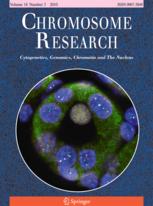 北卡罗莱纳州立大学的研究人员揭示了在犬类染色体上的进化“断点”与犬类癌症有关的证据。绘制犬类中这些“易碎”区域的图谱也对发现和治疗人类癌症具有启示作用。
北卡罗莱纳州立大学的研究人员揭示了在犬类染色体上的进化“断点”与犬类癌症有关的证据。绘制犬类中这些“易碎”区域的图谱也对发现和治疗人类癌症具有启示作用。
当新的种进化时,它们以“断点区域”的形式留下了遗传学证据。这些区域在新种形成期间(形成新的狗种)形成于染色体发生断裂的基因组上。北卡罗莱纳州立大学的遗传学教授Matthew Breen和研究生Shannon Becker研究了在进化中犬科动物不同种分化时发生的断点区域。他们将几种野生犬种与那些家养的狗进行基因组对比后在11个不同犬种中发现了共有的断点,即所谓的进化断点。
“关于犬类染色体中的断点区,一件有意思的事情是,我们已证实与自发癌症发生中染色体断裂有关的那些区域是相同区域,”Breen说。“有可能是当犬科的发生种间分化时出现的染色体重排导致了染色体上出现不合适的区域,这也是为什么这些区域与癌症有关。”
该研究结果发表在《Chromosome Research》杂志上。
“在物种进化时,编码在染色体上的遗传信息会进行重建——这就导致了近源物种具有按不同方式进行组织的基因组,”Becker说。“在某些情况下,进化的物种需要额外的染色体,称为B染色体。我们研究了3个犬种中的这些额外的B染色体发现它们拥有几个癌症相关基因。我们的工作为分化过程中癌症相关基因不稳定性与基因重排间存在联系添加了证据。”
“在犬类B染色体上出现的癌症相关基因簇表明,以前认为没有活性的这些染色体可能在隔离分化中所产生基因的多余拷贝中发挥着重要作用,”Breen补充说。“我们现在需要确定这些储存的基因是活跃的还是没有活性的——这个信息能够给我检测和治疗癌症提供新的工具。”(生物探索)
相关英文论文摘要:
Anchoring the dog to its relatives reveals new evolutionary breakpoints across 11 species of the Canidae and provides new clues for the role of B chromosomes
The emergence of genome-integrated molecular cytogenetic resources allows for comprehensive comparative analysis of gross karyotype architecture across related species. The identification of evolutionarily conserved chromosome segment (ECCS) boundaries provides deeper insight into the process of chromosome evolution associated with speciation. We evaluated the genome-wide distribution and relative orientation of ECCSs in three wild canid species with diverse karyotypes (red fox, Chinese raccoon dog, and gray fox). Chromosome-specific panels of dog genome-integrated bacterial artificial chromosome (BAC) clones spaced at ∼10-Mb intervals were used in fluorescence in situ hybridization analysis to construct integrated physical genome maps of these three species. Conserved evolutionary breakpoint regions (EBRs) shared between their karyotypes were refined across these and eight additional wild canid species using targeted BAC panels spaced at ∼1-Mb intervals. Our findings suggest that the EBRs associated with speciation in the Canidae are compatible with recent phylogenetic groupings and provide evidence that these breakpoints are also recurrently associated with spontaneous canine cancers. We identified several regions of domestic dog sequence that share homology with canid B chromosomes, including additional cancer-associated genes, suggesting that these supernumerary elements may represent more than inert passengers within the cell. We propose that the complex karyotype rearrangements associated with speciation of the Canidae reflect unstable chromosome regions described by the fragile breakage model.
英文论文链接:https://www.springerlink.com/content/t150pj36q00617w5/







